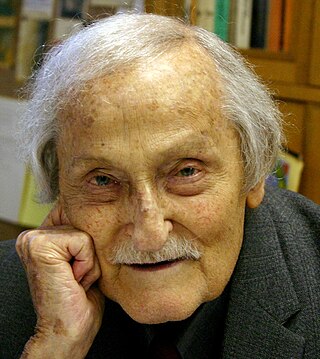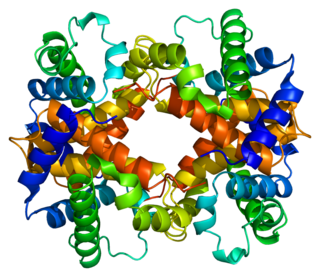
Trefor Jenkins (born 24 July 1932 in Merthyr Vale [1] ) is a human geneticist from South Africa, noted for his work on DNA. He is the former dean of the medical school at the University of Witwatersrand.

Trefor Jenkins (born 24 July 1932 in Merthyr Vale [1] ) is a human geneticist from South Africa, noted for his work on DNA. He is the former dean of the medical school at the University of Witwatersrand.
Jenkins qualified in medicine at King's College and Westminster Hospital in London. He came to Africa as a mine medical officer in Southern Rhodesia in 1960 where he first encountered sickle cell anaemia which started his interest in genetics.
He contributed significantly to the knowledge of gene markers in different populations through his work on the genetics of blood groups and DNA polymorphisms, which helped to clarify the origins of indigenous groups in Africa. He also studied sickle cell anaemia and albinism at the molecular level. He has published and collaborated in over 300 papers and two books. [2]
Jenkins also pioneered an undergraduate teaching project in Medical Ethics at the University of the Witwatersrand and made considerable contributions in this field, notably in the ethical ramifications of molecular biology. Jenkins was also a human rights activist, and was one of six doctors, who questioned the ethics of the medical establishment and the previous South African government after the death, in custody, of Steve Biko, the Black Consciousness leader, in September 1977.
He retired from full-time professorial duties in 1997, but continues to teach at Witwatersrand University and work at the Division of Human Genetics, National Health Laboratory Service. [3] Jenkins headed the Department of Human Genetics, School of Pathology, at the former South African Institute for Medical Research and at the University of the Witwatersrand, between June 1975 and September 1998. He is now emeritus professor and an honorary professorial research fellow as well as honorary lecturer in bioethics.
Biomedicine is a branch of medical science that applies biological and physiological principles to clinical practice. Biomedicine stresses standardized, evidence-based treatment validated through biological research, with treatment administered via formally trained doctors, nurses, and other such licensed practitioners.

Phillip Vallentine Tobias was a South African palaeoanthropologist and Professor Emeritus at the University of the Witwatersrand in Johannesburg. He was best known for his work at South Africa's hominid fossil sites. He was also an activist for the eradication of apartheid and gave numerous anti-apartheid speeches at protest rallies and also to academic audiences.

Hemoglobin subunit beta is a globin protein, coded for by the HBB gene, which along with alpha globin (HBA), makes up the most common form of haemoglobin in adult humans, hemoglobin A (HbA). It is 147 amino acids long and has a molecular weight of 15,867 Da. Normal adult human HbA is a heterotetramer consisting of two alpha chains and two beta chains.

Thiamine transporter 1, also known as thiamine carrier 1 (TC1) or solute carrier family 19 member 2 (SLC19A2) is a protein that in humans is encoded by the SLC19A2 gene. SLC19A2 is a thiamine transporter. Mutations in this gene cause thiamine-responsive megaloblastic anemia syndrome (TRMA), which is an autosomal recessive disorder characterized by diabetes mellitus, megaloblastic anemia and sensorineural deafness.

Rick Antonius Kittles is an American biologist specializing in human genetics and a Senior Vice President for Research at the Morehouse School of Medicine. He is of African-American ancestry, and achieved renown in the 1990s for his pioneering work in tracing the ancestry of African Americans via DNA testing.

Harvey Akio Itano was an American biochemist best known for his work on the molecular basis of sickle cell anemia and other diseases. In collaboration with Linus Pauling, Itano used electrophoresis to demonstrate the difference between normal hemoglobin and sickle cell hemoglobin; their 1949 paper "Sickle Cell Anemia, a Molecular Disease" was a landmark in both molecular medicine and protein electrophoresis.
"Sickle Cell Anemia, a Molecular Disease" is a 1949 scientific paper by Linus Pauling, Harvey A. Itano, Seymour J. Singer and Ibert C. Wells that established sickle-cell anemia as a genetic disease in which affected individuals have a different form of the metalloprotein hemoglobin in their blood. The paper, published in the November 25, 1949 issue of Science, reports a difference in electrophoretic mobility between hemoglobin from healthy individuals and those with sickle-cell anemia, with those with sickle cell trait having a mixture of the two types. The paper suggests that the difference in electrophoretic mobility is probably due to a different number of ionizable amino acid residues in the protein portion of hemoglobin, and that this change in molecular structure is responsible for the sickling process. It also reports the genetic basis for the disease, consistent with the simultaneous genealogical study by James V. Neel: those with sickle-cell anemia are homozygous for the disease gene, while heterozygous individuals exhibit the usually asymptomatic condition of sickle cell trait.

Sickle cell disease (SCD) is a group of blood disorders typically inherited. The most common type is known as sickle cell anaemia. It results in an abnormality in the oxygen-carrying protein haemoglobin found in red blood cells. This leads to a rigid, sickle-like shape under certain circumstances. Problems in sickle cell disease typically begin around 5 to 6 months of age. A number of health problems may develop, such as attacks of pain, anemia, swelling in the hands and feet, bacterial infections and stroke. Long-term pain may develop as people get older. The average life expectancy in the developed world is 40 to 60 years.
Himla (Himladevi) Soodyall is a South African geneticist involved in finding some of the oldest human genetic lines, mainly focusing on Sub-Saharan Africa. Her work on DNA has pointed to southern Africa as the most likely geographic region of origin of the human species.
Human genetic resistance to malaria refers to inherited changes in the DNA of humans which increase resistance to malaria and result in increased survival of individuals with those genetic changes. The existence of these genotypes is likely due to evolutionary pressure exerted by parasites of the genus Plasmodium which cause malaria. Since malaria infects red blood cells, these genetic changes are most common alterations to molecules essential for red blood cell function, such as hemoglobin or other cellular proteins or enzymes of red blood cells. These alterations generally protect red blood cells from invasion by Plasmodium parasites or replication of parasites within the red blood cell.

Julie Makani is a Tanzanian medical researcher. From 2014 she is Wellcome Trust Research Fellow and Associate Professor in the Department of Haematology and Blood Transfusion at the Muhimbili University of Health and Allied Sciences (MUHAS). Also a visiting fellow and consultant to the Nuffield Department of Medicine, University of Oxford, she is based in Dar es Salaam, Tanzania. In 2011, she received the Royal Society Pfizer Award for her work with sickle cell disease.
Adeyinka Gladys Falusi, FAS NPOM, is a Nigerian Professor of haematology and former Director of the Institute for Advanced Medical Research and Training, College of Medicine, University of Ibadan.
Anthony Clifford Allison was a South African geneticist and medical scientist who made pioneering studies on the genetic resistance to malaria. Clark completed his primary schooling in Kenya, completed his higher education in South Africa, and obtained a BSc in Medical Science from the University of the Witwatersrand in 1947. He earned his PhD from the University of Oxford in 1950. After working at the Radcliffe Infirmary for two years, he worked as post-doctoral student to Linus Pauling in 1954. After teaching medicine for three years at Oxford, he worked at the Medical Research Council in London. In 1978 he simultaneously worked at the International Laboratory for Research on Animal Diseases (ILRAD) as its Director, and at the World Health Organization's (WHO) Immunology Laboratory, both in Nairobi. He later became the Vice President for Research at Syntex Corporation (1981-1994).
Frances Rix Ames was a South African neurologist, psychiatrist, and human rights activist, best known for leading the medical ethics inquiry into the death of anti-apartheid activist Steve Biko, who died from medical neglect after being tortured in police custody. When the South African Medical and Dental Council (SAMDC) declined to discipline the chief district surgeon and his assistant who treated Biko, Ames and a group of five academics and physicians raised funds and fought an eight-year legal battle against the medical establishment. Ames risked her personal safety and academic career in her pursuit of justice, taking the dispute to the South African Supreme Court, where she eventually won the case in 1985.
Felix Israel Domeno Konotey-Ahulu FGA, FRCPSG, FRCP, FWACP is a Ghanaian physician and scientist who is Kwegyir Aggrey Distinguished Professor of Human Genetics at the University of Cape Coast, Ghana, and a consultant physician/genetic counsellor, Haemoglobinopathy/Sickle Cell States, in Harley Street, London. He is one of the world's foremost experts on sickle-cell disease.
Robert Williamson is a retired British-Australian molecular biologist who specialised in the mapping, gene identification, and diagnosis of human genetic disorders.

Swee Lay Thein is a Malaysian haematologist and physician-scientist who is Senior Investigator at the National Institutes of Health. She works on the pathophysiology of haemoglobin disorders including sickle cell disease and thalassemia.
Hermann Lehmann was a German-born British physician and biochemist known for his works on the chemistry and diversity of hemoglobin. Describing about 75 different hemoglobin, he discovered the most number of hemoglobin types than anyone else. He is regarded as one of the founders of molecular anthropology.
Ambroise Wonkam is a Cameroonian medical doctor and professor of medical genetics at Johns Hopkins School of Medicine. His research is in sickle cell disease, the genetics of congenital hearing impairment, and ethics in human genetics. He is the current president of the African Society of Human Genetics.
Haig H. Kazazian, Jr. was a professor in the Department of Genetic Medicine at Johns Hopkins University School of Medicine in Baltimore, Maryland. Kazazian was an elected member of the National Academy of Sciences and the American Academy of Arts and Sciences.